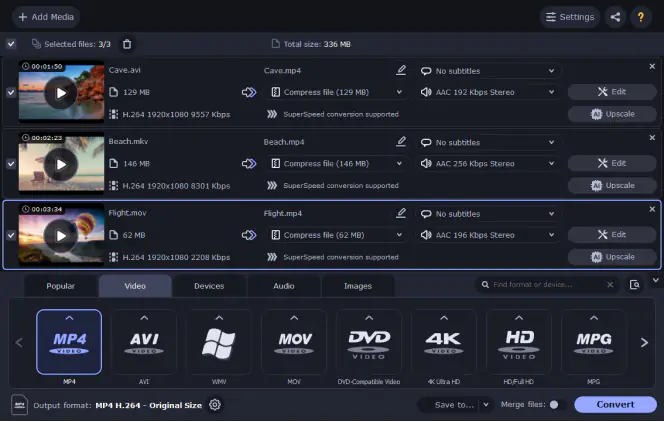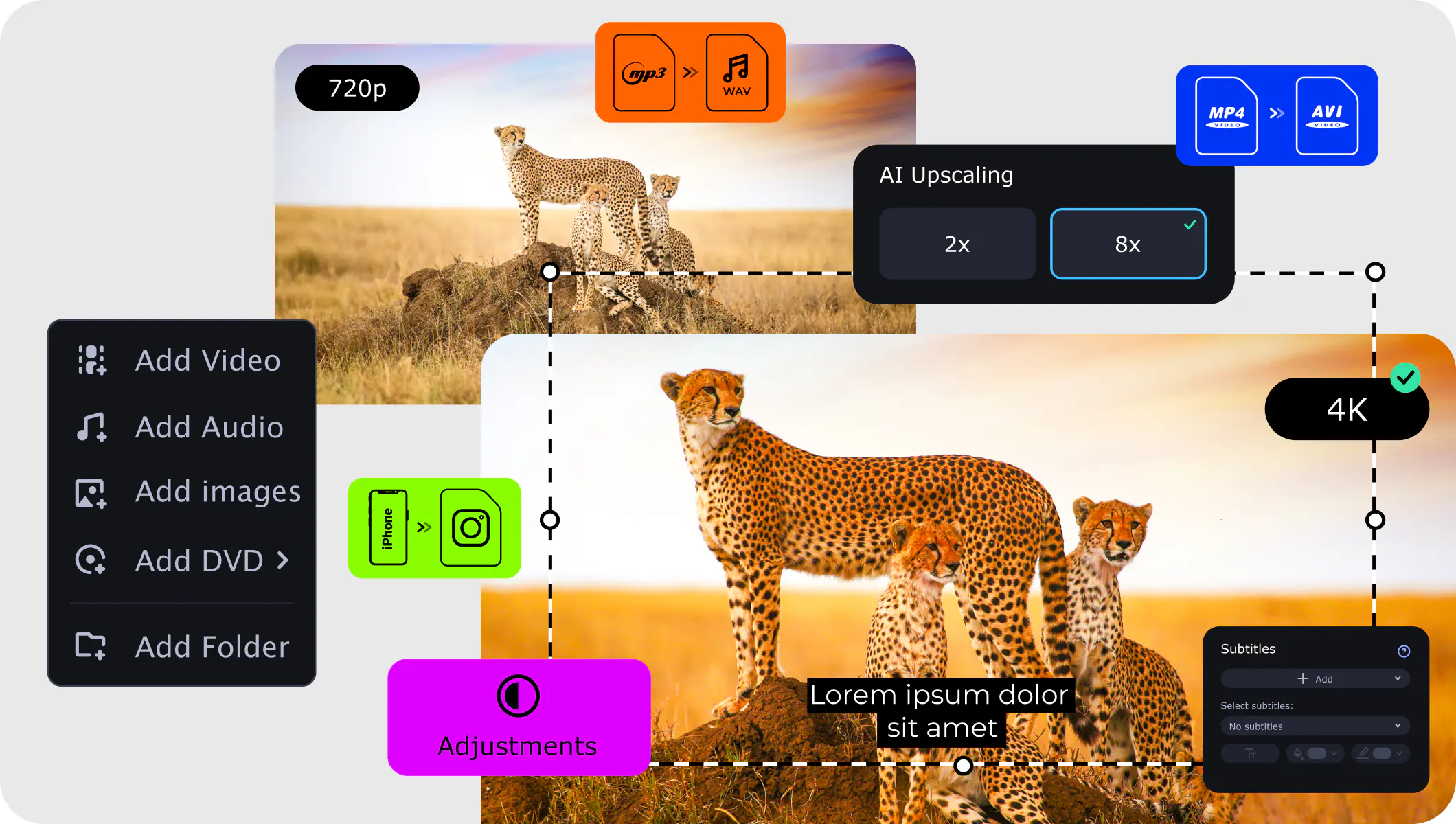AIFF vs. WAV: Which Format is Better
To convert an audio, follow these simple steps:
- Download and launch Movavi Video Converter.
- Add your files to the program.
- Choose the output format.
- Convert the audio.
Determining the AIFF vs. WAV contest may not be easy because both audio formats output the same quality of sound. Even the most experienced DJ may not tell if there is any noticeable difference between the two audio file formats. But the main difference between the two is that AIFF contains metadata, while WAV doesn't.
Here’s what Movavi’s team does to provide you with verified information:
When selecting products to include in our reviews, we research both demand and popularity.
All the products covered in this article have been tested by our team.
When testing, we compare key characteristics, including supported input and output formats, quality loss when converting, and other significant features.
We study user reviews from popular review platforms and make use of this information when writing our product reviews.
We collect feedback from our users and analyze their opinions of Movavi software as well as products from other companies.

Special pick: Movavi Video Converter

If you need to convert your AIFF or WAV files, our special pick for you is Movavi Video Converter. It can convert your video and audio files to over 180 different formats in a couple of clicks and edit the result with built-in options. The interface is easy-to-use, so even a beginner won’t have any problems using it.
AIFF and WAV play on almost all kinds of computers and devices, though AIFF works mostly for Macs, while WAV is for Windows. The two audio formats employ the same type of encoding that results in large file sizes, but have a better quality sound compared to MP3 and M4V. In the contest pitting AIFF versus WAV, it would be difficult to determine the winner without a detailed analysis of each.
So, what is a WAV file? Short for Waveform Audio File Format, WAV is one of the oldest and simplest high-resolution audio formats developed by IBM and Microsoft in 1991. This audio format works by converting audio signals into binary data, which is then stored as a bitstream format on PC. It stores data in chunks, just like the AIFF format used on Mac computers.
WAV forms the Windows main audio format for raw and uncompressed audio files that use the usual bitstream encoding known as the Linear Pulse Code Modulation (LPCM). The LPCM is the standard coding format for audio CDs that store 2-channel LPCM audio with a sampling of 44,100Hz with 16 bits for each sample.
If you are a professional user and want to do some DJing, WAV would be your best bet. This is because you can easily edit or manipulate WAV files using some software. Although this audio format is by nature uncompressed, allowing for higher quality output, you can compress it on Windows using the Audio Compression Manager (ACM) codec.
You can access the ACM codec via various programs that use them. A good example of such programs is the Sound Recorder found in some versions of Windows OS. But from Windows 2000, the WAV format can specify multiple audio channel data as well as the exact speaker positions to eliminate ambiguity in its output.
Pros
Lossless uncompressed format: possible to reproduce a recording without loss in quality.
Simple: WAV files are easy to process and edit, even for DJing.
High dynamic range: with a high dynamic range of up to 192 kHz, this audio format is best for broadcast companies.
Smoother loops: regular frequency makes this audio format produce smooth sound regardless of the file size and beatport.
Can work as an interchange medium between platforms: whichever platform you are operating on, WAV can help in transitioning smoothly between different audio formats.
Cons
Large file sizes: since WAV is mostly uncompressed, it takes up large spaces on the storage medium. A minute of this audio length may take up to 10 MB of space.
Compatibility issues with some playback devices and online use: because of its large size, WAV may have compatibility issues with lighter platforms.
Limited support and portability: not many devices support WAV playback, hence, confining to PCs.
Can get corrupted easily: this audio format is easy to process, edit, and manipulate, hence, a user can easily corrupt it.
Not suitable for online sharing: this file system occupies large chunks of space, making it difficult to share online. You may need to compress it to a smaller file size through conversion to other lighter audio formats, such as MP3, before you can share it via the web.
So, what is an AIFF file? It stands for Audio Interface File Format, an audio file format developed by Apple in 1988. It is based on the IFF (Interchange File Format). You are more familiar with the MP3 format, but when it comes to the AIFF, you are looking at an uncompressed audio file that retains a higher quality compared to MP3.
But the uncompressed audio files mean that it will occupy more space on your storage media, up to 10 MB per minute of audio recording. It could be a small price to pay if you are looking for high-quality audio output.
AIFF works mostly on Macs and iOS devices, it can also play on Windows with certain media players, such as VLC. Windows appends .aif to such files before reading them, while Macs attach .aiff to them. This means that Windows users will see .aif while those on Mac will see the extension .aiff.
However, it is still possible to compress this audio file format. There is a variant that can utilize compression to achieve less disk space and is called AIFF-C, or simply AIFFC, which stands for Compressed Audio Interchange file Format. As expected, compressed versions of AIFF will have the extension .aifc.
You can open and play AIFF media on Apple iTunes, VLC, Media Player Classic, Windows Media Player, and most other multi-format media players. If you are a Mac user, use those Apple programs to play these audio files, including Roxio Toast. iPhones and iPads should play these audio formats natively without a special app, but if you want to play them on Android phones, you will have to convert to compatible files.
Pros
High quality: AIFF is a lossless format that provides better quality audio compared to other audio file formats.
High dynamic range: best for audio recording and broadcast since it experiences no decline in quality during recording and playback.
Simple: this format is easy to process and edit, and even create beatports, hence, quite suitable for the DJ.
Compatibility: AIFF can play on almost all media devices, some natively, while others need an app.
Cons
Difficult adding tags: due to its very nature, this file format isn't flexible enough for adding tags even though it has room for metadata.
Difficult to share online: it takes up much space because it is uncompressed. As such, it is difficult to share online.
Large files: AIFF occurs in uncompressed chunks of files, occupying lots of space. A minute of this audio file length occupies about 10 MB.
Movavi Video Converter
The ideal way to get your media in the format you need!

Similar guides

Have questions?
If you can’t find the answer to your question, please feel free to contact our Support Team.
Join for how-to guides, speсial offers, and app tips!
1.5М+ users already subscribed to our newsletter